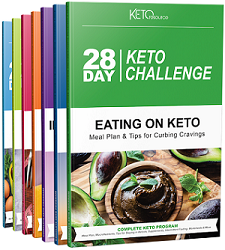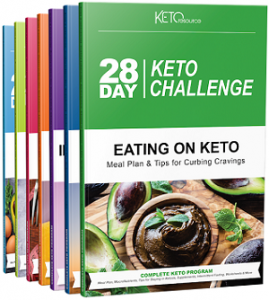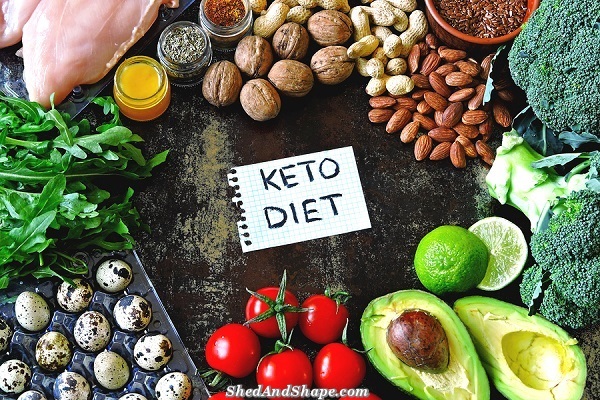With keto being one of the most popular diets today, more and more people are asking how does the keto diet work? Remember that before you start any diet plan, it’s important that you do your research well.
Although the ketogenic lifestyle is very effective for the majority of people, you may not get the results that you want if you do it the wrong way.
You’ll find thousands of resources online when you search for how does the keto diet work. Some say the keto diet is safe and effective, brilliant for weight loss, an energy and mood booster, good for relieving joint pain, a cure for type 2 diabetes and other diseases, but others express their skepticism about some aspects of the diet.
Related reading: 5 Amazing Health Benefits of a Keto Diet
If you are new to keto, read on to find out how the diet works, so you can decide for yourself if it’s the right diet for you.
What is the Keto Diet?
The keto diet also known as the ketogenic diet, is a diet that consists of eating very low-carb and high healthy fat foods, with some good quality protein. According to Heather Mangieri, a sports nutrition specialist and registered dietitian based in Pittsburgh,
“In a nutshell, keto is a high-fat, extremely low-carb diet with an “adequate” amount of protein thrown in.”
Although the keto diet is only gaining popularity recently, this diet is not entirely new. This diet was originally developed in the 1920s to treat epilepsy in kids. It’s still used for the same purpose today and is being studied as a potential cure for neurological disorders and a wide range of diseases.
The typical macronutrient ratio for a keto diet:
-
- 60 to 75 percent of calories from fat
- 15 to 30 percent from protein
- 5 or 10 percent of the calories from carbs

Take the 28 Day Keto Challenge!
You can save yourself a lot of working out these macros with the 28 Day Keto Challenge. The 28-Day Meal Plan guides you every step of the way. You’re never left to figure things out on your own.
Click here to get started now!
How Does the Keto Diet Work?
When you follow the ketogenic diet, you need to significantly reduce your carb consumption. In exchange for carbs, you’ll have to consume high-fat foods and some proteins.
Related reading: How Many Carbs Do You Need To Eat To Lose Weight?
By drastically reducing your carbohydrate intake and replacing your carbs with fats, you will be putting your body into a metabolic state known as “ketosis’.
Normally, our bodies burn carbohydrates to be used for energy. When we eat foods that are rich in carbohydrates, the carbs will be broken down to glucose by digestion.
Eventually, the insulin triggered by the glucose entering the blood, will carry the glucose into cells where it will be stored for energy or fat if it is not required for energy. The constant consumption of carbs makes your body rely mainly on glucose for energy.
If you’re going to restrict your carb intake by following the keto diet, there will not be enough carbs for your body to burn. In this case, your body will end up breaking the fats you have consumed into ketones, which is what fuels your body for energy.
Basically, the keto diet forces your body to convert fats into fuel. It encourages the body to produce ketones, which will then be used for energy.
What Is Ketosis?
What’s unique about the ketones is that they are rapidly taken by the tissues and broken down immediately to produce ATP, which is the body’s main energy currency. This process of using ketones for energy is what’s known as ketosis, which is a normal physiological process.
Contrary to what many people believe, the state of ketosis is not at all dangerous. Dr. Anthony Gustin, a chiropractor turned Functional Medicine practitioner has stated that,
“Ketosis is a normal metabolic state of using fat for a primary fuel source that is really beneficial. It is often confused with Ketoacidosis, which is indeed a serious condition and problem that shouldn’t be brushed off as irrelevant.”
People who are misinformed are the ones who find ketosis to be dangerous. But it is a truly safe and normal physiological process that encourages your body to use ketones for energy.
How to Follow the Keto Diet?
Now that your question of how does the keto diet work is addressed, it’s time to learn the basic steps to get started with the keto diet. Dr. Chris Kresser has recommended a three-step process to starting the keto diet:
Related reading: What are the Basic Rules of Keto Diet?
1 – Know Your Macronutrient Ratio
The main goal of the keto diet is to transition your body into the state of ketosis. To reach this goal, you need to strictly follow the following keto macros:
60 – 75 percent of calories from fat
15 – 30 percent of calories from protein
5 – 10 percent of calories from carbohydrates
Here’s a sample keto meal:
Breakfast – 2 fried organic eggs cooked in butter, 2 slices of grass-fed bacon, 1/2 cup sautéed mushrooms, 3/4 cup organic spinach.
Related reading: 5 Low Carb Breakfasts To Energize Your Day
Lunch – 6 slices of grass-fed bacon, 2 slices of grilled organic or free range chicken, 1 oz. of cheese, 2 tbsp. of good quality mayo, and 5 organic cherry tomatoes
Related reading: What’s So Good About Grass-Fed Meat?
Dinner – baked wild salmon fillet, 3/4 cup mashed cauliflower, 1 slice grass-fed bacon
2 – Do Not Count Calories
Unlike other diets, counting calories is not necessary on the keto diet. To be successful on the diet you should make sure to keep track of your daily macronutrients. You can use a journal to take note of the foods that you eat. Better yet, download keto apps that can help you to keep track of your calorie consumption.
3 – Test Your Ketones Regularly
To know if you’re in ketosis, test your ketones regularly. There are ketone testing kits that you can use for this. If you don’t have the testing kit yet, refer to this article for tips on how to tell if you are in ketosis without testing.
Things to Keep In Mind
Now that you’ve done your research on how does the keto diet work, you should be all set for following the ketogenic lifestyle. In the first few days, however, as will any change of diet, it’s not unusual to suffer from a few minor side effects.
Since the keto diet is extreme, you’ll feel weak and lousy at the start. This is because your body is still trying to adapt to your new food choices. For a long time, your body has been used to carbs. So when you finally restrict your carb consumption, strange things could happen.
But this is not something to worry about because the side effects are not harmful. Eventually, once your body transitions to ketosis, these side effects will be minimized and will eventually go away.
At the end of the day, the key is to stick to your macronutrient and choose foods that are healthy and nourishing for your body.
 Ready to get started on Keto? Take the 28 Day Keto Challenge. The 28-Day Keto Challenge is a well-crafted plan that guides you through your first month. You’re never left to figure things out on your own. The 28-Day Meal Plan guides you every step of the way.
Ready to get started on Keto? Take the 28 Day Keto Challenge. The 28-Day Keto Challenge is a well-crafted plan that guides you through your first month. You’re never left to figure things out on your own. The 28-Day Meal Plan guides you every step of the way.










